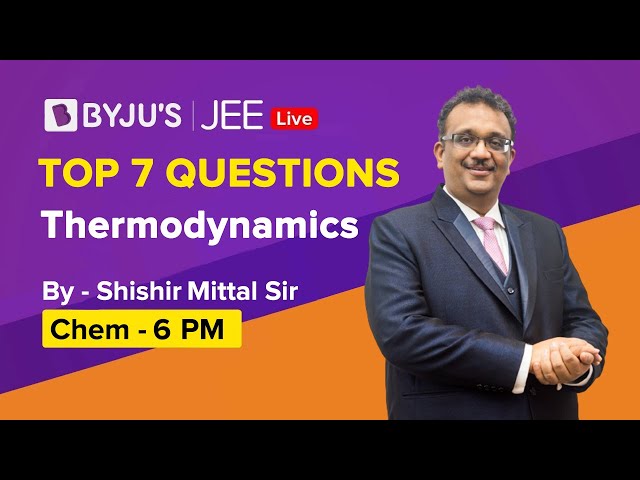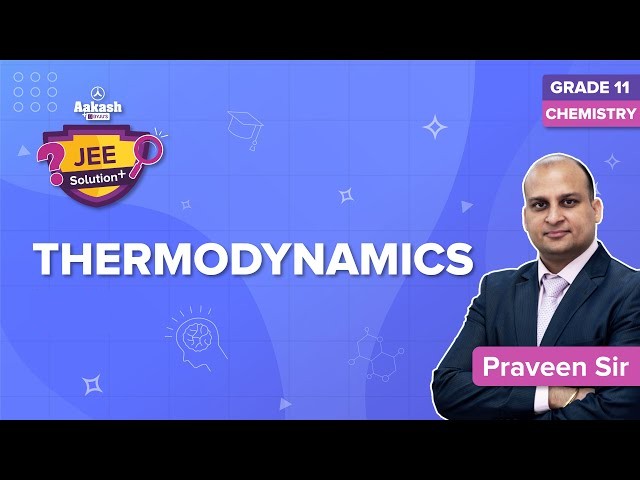Thermodynamics deals with the study of the conversion of heat into mechanical work and also other forms of energy. The principles of thermodynamics are fundamental to many branches of physics, chemistry, aerodynamics and mechanical engineering. The study of energy relations and the manner in which these changes take place are based on two laws – the first and the second law of thermodynamics. The first law gives the relation between heat and mechanical work, while the second law shows the manner in which these energy changes take place.
Download Thermodynamics JEE Advanced Previous Year Questions With Solutions PDF
Question 1) Consider the P-V diagram given below for a cyclic process. Find the net heat supplied to the system during the process.

(a) 0.625п J
(b) 0.25п J
(c) 0.1п J
(d) 0.2п J
Answer: (b) 0.25п J
Solution:
It is a cyclic process so the net change in internal energy of the system will be zero. i.e.,
ΔU = 0
From first law of thermodynamics,
ΔQ = ΔU + ΔW
Therefore, ΔQ = ΔW
ΔW is the area of the shaded region
Qcycle = Wcycle = π(25)(10) Kpa-cc
= π(25)(10) × 103 × 10-6
= 0.250 πJ
Question 2) Four molecules of a diatomic gas are heated from 0°C to 50°C. Find the heat supplied to the gas if work done by it is zero.
(a) 780 R
(b) 500 R
(c) 100 R
(d) 650 R
Answer:(b) 500 R
Solution:
For a diatomic molecule
Cv = 5R/2
Cp = 7R/2
Number of moles, n = 4
ΔT = 50
So, Work done = 0, the process is isochoric
In an isochoric process, Q = ΔU = nCvΔT
Therefore, Q = (4)(5R/2)(50)
= 500 R
Question 3) A gas is undergoing change in state by an isothermal process AB as follows. Work done by gas in process AB is

(a) 100 ln2 Joule
(b) −100 ln2 Joule
(c) 200 ln2 Joule
(d) −200 ln2 Joule
Answer: (c) 200 ln2 Joule
Solution:
Wisothermal = P1V1 in (V2/V1)
V1 = 100 m3
V2 = 200 m3
P1 = 2 N/m2
Wisothermal = 2 × 100 In (200/100)
= 200 In2 Joule
Question 4) A thermally insulating cylinder has a thermally insulating and frictionless movable partition in the middle, as shown in the figure below. On each side of the partition, there is one mole of an ideal gas, with specific heat at constant volume, CV = 2R. Here, R is the gas constant. Initially, each side has a volume V0 and temperature T0. The left side has an electric heater, which is turned on at very low power to transfer heat Q to the gas on the left side. As a result, the partition moves slowly towards the right, reducing the right side volume to V0 /2. Consequently, the gas temperatures on the left and the right sides become TL and TR, respectively. Ignore the changes in the temperatures of the cylinder, heater and partition.

The value of TR/T0 is
(a) √2
(b) √3
(c) 2
(d) 3
Answer: (a)√2
Solution:
PVץ = C
Question 5) A thermally insulating cylinder has a thermally insulating and frictionless movable partition in the middle, as shown in the figure below. On each side of the partition, there is one mole of an ideal gas, with specific heat at constant volume, CV = 2R. Here, R is the gas constant. Initially, each side has a volume V0 and temperature T0. The left side has an electric heater, which is turned on at very low power to transfer heat Q to the gas on the left side. As a result the partition moves slowly towards the right, reducing the right side volume to V0 /2. Consequently, the gas temperatures on the left and the right sides become TL and TR, respectively. Ignore the changes in the temperatures of the cylinder, heater and partition. The value of Q/RT0 is
(a) 4(2√2 + 1)
(b) 4(2√2 – 1)
(c) (5√2 + 1)
(d) (5√2 – 1 )
Answer: (b) 4(2√2 – 1)
Solution:
Q = ΔU1 + ΔU2
ΔU1 = CVΔT1 = 2R(TL – T0)
ΔU2 = CVΔT2 = 2R(TR – T0)
T L = 3√2T0 , TR = √2T0
Q = 2R[3√2 – 1]T0+ 2R(√2 – 1]T0
Q = 4RT0[2√2 – 1]
⇒ Q/RT0 = 4[2√2 – 1]
Question 6) 200 g water is heated from 40°C to 60°C. Ignoring the slight expansion of water, the change in its internal energy is close to (Given specific heat of water = 4184 J/kgK)
(a) 167.4 kJ
(b) 8.4 kJ
(c) 4.2 kJ
(d) 16.7 J
Answer: (d) 16.7 J
Solution:
The volume of water does not change, no work is done on or by the system (W = 0)
According to the first law of thermodynamics
Q = ΔU + W
For the isochoric process, Q = ΔU
ΔU = mcdT = 0.2 × 4184 × 20 = 16.7 kJ
Question 7) In a given process on an ideal gas, dW = 0 and dQ<0. Then for the gas
(a) the temperature will decrease
(b) the volume will increase
(c) the pressure will remain constant
(d) the temperature will increase
Answer: (a) the temperature will decrease
Solution:
From the first law of thermodynamics
dQ = dU + dW
Here dW = 0 (given)
Therefore, dQ = dU
Now since dQ <0, dQ is negative, so dU decreases.
When internal energy ‘U’ decreases, temperature ‘T’ decreases.
Question 8) A gas is compressed from a volume of 2m3 to a volume of 1m3 at a constant pressure of 100 N/m2. Then it is heated at constant volume by supplying 150 J of energy. As a result, the internal energy of the gas:
(a) Increases by 250 J
(b) decreases by 250 J
(c) increases by 50 J
(d) decreases by 50 J
Answer: (a) Increases by 250 J
Solution:
As we know,
ΔQ = Δu + ΔW
⇒ ΔQ = Δu + PΔV
150 = Δu +100 (1 – 2)
Δu = 150 + 100 = 250 J
Question 9) During the melting of a slab of ice at 273 K at atmospheric pressure,
(a) positive work is done by the ice water system on the atmosphere.
(b) positive work is done by the ice water system by the atmosphere.
(c) the internal energy of the ice-water system increases.
(d) the internal energy of the ice-water system decreases.
Answer: (b) positive work is done by the ice water system by the atmosphere and (c) the internal energy of the ice-water system increases.
Solution:
There is a decrease in volume during the melting of an ice slab at 273 K.
Question 10) A thermally insulated vessel contains 150 g of water at 00C. Then the air from the vessel is pumped out adiabatically. A fraction of water turns into ice and the rest evaporates at 00C itself. The mass of evaporated water will be close to (Latent heat of vaporization of water = 2.10 × 106 J/kg and latent heat of fusion of water = 3.36 × 105 J/kg)
(a) 150 g
(b) 20 g
(c) 130 g
(d) 35 g
Answer: (b) 20 g
Solution:
Suppose the amount of water evaporated is M gram.
Then (150 – M) grams of water is converted to ice.
So, heat consumed in evaporation = heat released in fusion
M × Lv = (150 – M) × Ls
M × 2.1 × 106 = (150 – M) × 3.36 × 105
⇒ M = 20 g
Also Read:
Thermodynamics JEE Main Previous Year Questions With Solutions
Thermodynamics Important Topics

Thermodynamics Important Questions

Thermodynamics Top 7 Questions

Thermodynamics JEE Solutions

In Question number 5 there is an error in the solution according to me TL will be (2/3)^1/2 , by applying the formula T1V1^(y-1)= T2V2^(y-1).
One more thing it is obvious as the volume of left side increases the temperature will decrease.